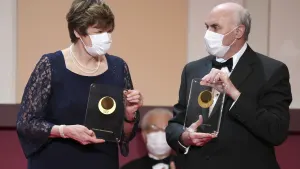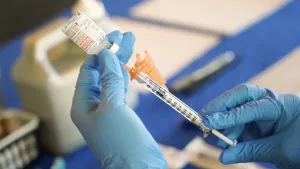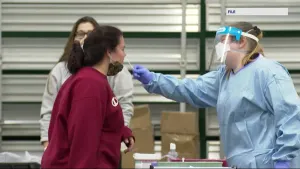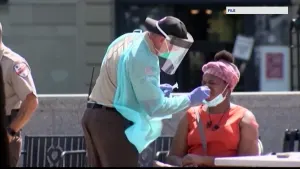CDC: US moving closer to point COVID-19 is no longer a 'constant crisis'
The nation's leading health officials said Wednesday that the U.S. is moving closer to the point that COVID-19 is no longer a “constant crisis” as more cities, businesses and sports venues began lifting pandemic restrictions around the country.
Share:
More Stories

Hometown Heroes in New York City
466ds ago
Nobel in medicine goes to 2 scientists whose work enabled creation of mRNA vaccines against COVID-19
762ds ago0:21

Biden administration announces $600M to produce COVID tests and will reopen website to order them
773ds ago1:54

Hochul: Updated COVID vaccine to be available in NY in the coming days
780ds ago2:22

New and rare COVID variant detected in NYC wastewater; Gov. Hochul urges caution
795ds ago2:39

City health officials: COVID-19 cases on the rise as new variant emerges
795ds ago
Hometown Heroes in New York City
466ds ago
Nobel in medicine goes to 2 scientists whose work enabled creation of mRNA vaccines against COVID-19
762ds ago0:21

Biden administration announces $600M to produce COVID tests and will reopen website to order them
773ds ago1:54

Hochul: Updated COVID vaccine to be available in NY in the coming days
780ds ago2:22

New and rare COVID variant detected in NYC wastewater; Gov. Hochul urges caution
795ds ago2:39

City health officials: COVID-19 cases on the rise as new variant emerges
795ds agoThe nation's leading health officials said Wednesday that the U.S. is moving closer to the point that COVID-19 is no longer a “constant crisis” as more cities, businesses and sports venues began lifting pandemic restrictions around the country.
Centers for Disease Control and Prevention Director Dr. Rochelle Walensky said during a White House briefing that the government is contemplating a change to its mask guidance in the coming weeks. Noting recent declines in COVID-19 cases, hospital admissions and deaths, she acknowledged “people are so eager” for health officials to ease masking rules and other measures designed to stop the spread of the coronavirus.
“We all share the same goal – to get to a point where COVID-19 is no longer disrupting our daily lives, a time when it won’t be a constant crisis – rather something we can prevent, protect against, and treat," Walensky said.
With the Omicron variant waning and Americans eager to move beyond the virus, government and business leaders have been out ahead of the CDC in ending virus measures in the last week, including ordering workers back to offices, eliminating mask mandates and no longer requiring proof of vaccine to get into restaurants, bars and sports and entertainment arenas.
COVID-19 infections and hospitalizations have fallen sharply in the U.S., with the seven-day rolling average for daily new cases dropping from about 453,000 two weeks ago to about 136,000 as of Tuesday, according to data from Johns Hopkins University. Hospitalizations are at levels similar to September, when the U.S. was emerging from the delta variant surge. Almost 65% of Americans are fully vaccinated.
“As a result of all this progress and the tools we now have, we are moving to a time where COVID isn’t a crisis but is something we can protect against and treat,” said Jeff Zients, the White House coronavirus response coordinator.
Walensky said the CDC “will soon put guidance in place that is relevant and encourages prevention measures when they are most needed to protect public health and our hospitals.” She suggested any changes will take into account measures of community transmission, as well as hospitalization rates or other gauges of whether infected people are becoming severely ill. They also would consider available bed space in hospitals.
Several states with indoor mask mandates announced last week they would be lifted in coming weeks, also citing promising numbers
Walensky said the CDC wants to “give people a break from things like mask-wearing" when circumstances improve, though be able to mask up again if things worsen. She also said there will be instances where people should continue to wear masks even if prevention measures ease. Examples include when individuals have symptoms of COVID-19 or are within 10 days after being diagnosed with it.
Centers for Disease Control and Prevention Director Dr. Rochelle Walensky said during a White House briefing that the government is contemplating a change to its mask guidance in the coming weeks. Noting recent declines in COVID-19 cases, hospital admissions and deaths, she acknowledged “people are so eager” for health officials to ease masking rules and other measures designed to stop the spread of the coronavirus.
“We all share the same goal – to get to a point where COVID-19 is no longer disrupting our daily lives, a time when it won’t be a constant crisis – rather something we can prevent, protect against, and treat," Walensky said.
With the Omicron variant waning and Americans eager to move beyond the virus, government and business leaders have been out ahead of the CDC in ending virus measures in the last week, including ordering workers back to offices, eliminating mask mandates and no longer requiring proof of vaccine to get into restaurants, bars and sports and entertainment arenas.
COVID-19 infections and hospitalizations have fallen sharply in the U.S., with the seven-day rolling average for daily new cases dropping from about 453,000 two weeks ago to about 136,000 as of Tuesday, according to data from Johns Hopkins University. Hospitalizations are at levels similar to September, when the U.S. was emerging from the delta variant surge. Almost 65% of Americans are fully vaccinated.
“As a result of all this progress and the tools we now have, we are moving to a time where COVID isn’t a crisis but is something we can protect against and treat,” said Jeff Zients, the White House coronavirus response coordinator.
Walensky said the CDC “will soon put guidance in place that is relevant and encourages prevention measures when they are most needed to protect public health and our hospitals.” She suggested any changes will take into account measures of community transmission, as well as hospitalization rates or other gauges of whether infected people are becoming severely ill. They also would consider available bed space in hospitals.
Several states with indoor mask mandates announced last week they would be lifted in coming weeks, also citing promising numbers
Walensky said the CDC wants to “give people a break from things like mask-wearing" when circumstances improve, though be able to mask up again if things worsen. She also said there will be instances where people should continue to wear masks even if prevention measures ease. Examples include when individuals have symptoms of COVID-19 or are within 10 days after being diagnosed with it.
More from News 12

Obiri sets women's NYC Marathon course record, Kipruto wins men's race in photo finish
1:54

Yankee Ferry, the last Ellis Island passenger boat, is for sale. Here's a look at its rich history
0:59

VOTE 2025: Last day of early voting across New York City
1:11

16-year-old from The Bronx fatally shot in Crown Heights
1:24

Sunny and bright today in The Bronx; tracking chance of rain for Monday
0:31
